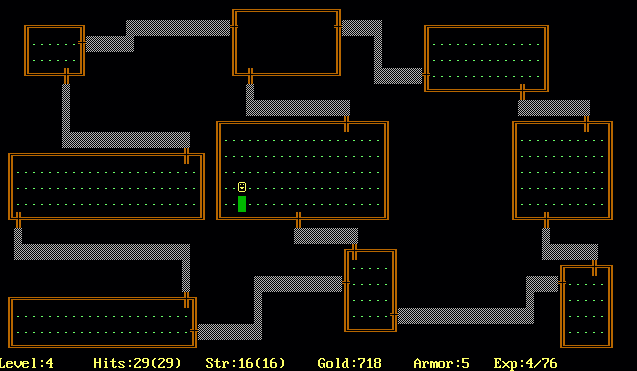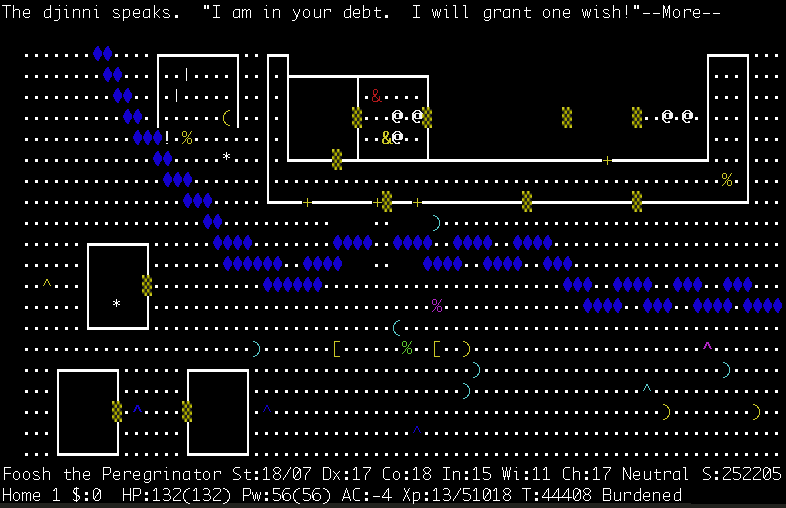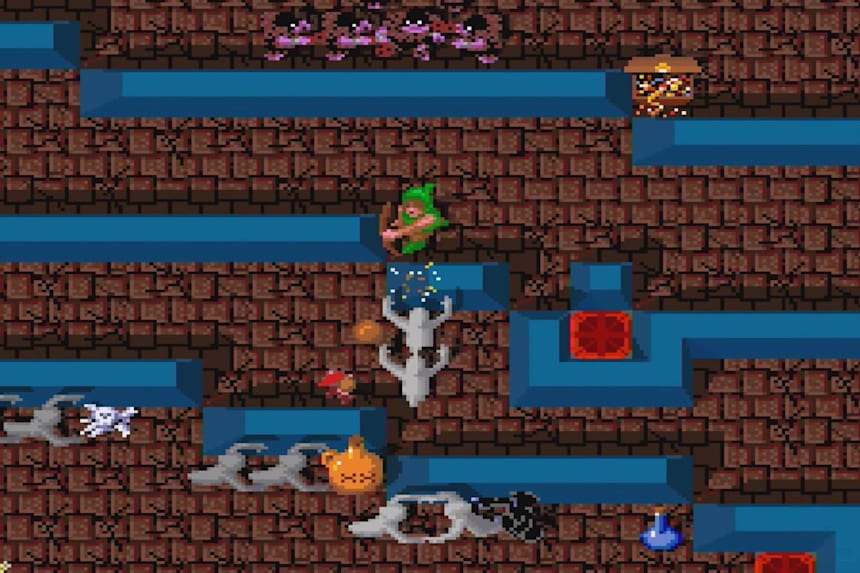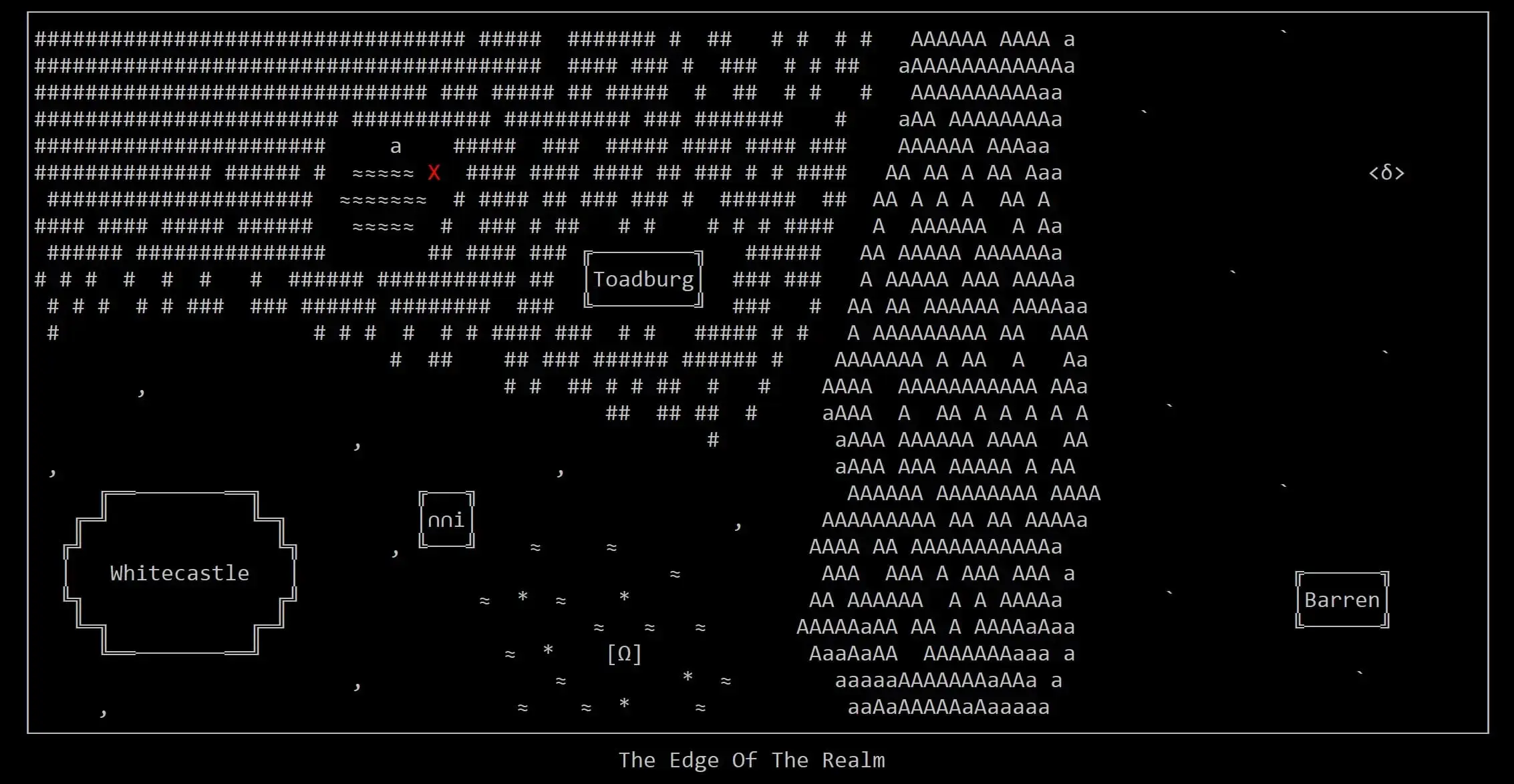The Complete History of Role-Playing Games (RPGs): Part 3 – Going Rogue
Ever wondered where the idea of character levels or XP came from? Why fantasy is final? What RPGs looked like before graphics, or what the first massively multiplayer games were like to play? Here at Ultimate Gaming Paradise, we’ve got all those answers and much more in our series, delving into the history of role-playing games.
Let there be graphics!
Episode Three: Going Rogue
ASCII.
Yeah, what’s that then? If you were a computing enthusiast in the 1980s, then ASCII was an acronym that put hitherto-unimagined power into your hands.
For the uninitiated, ASCII—pronounced ass-key—stands for American Standard Code for Information Interchange, but that really makes you no wiser. It actually meant for programming that there were many characters that you could make appear on a computer screen that made sense to the user in an effortless way—as text.
Remember those adventure games, with their text-based descriptions of locations? Well, what if instead of writing a sentence, you used some of the more obscure characters, like #%* and others, to represent a picture? All of a sudden, you are using the basic technology of on-screen text to make graphics.
ASCII pictures were groundbreaking. In a modern world of high-definition graphics, it can be hard to even imagine how anyone was ever impressed, but to those who had seen nothing but the boring text on a computer monitor ever, an ASCII picture of a flower, a dragon, or even a human face was on par with the renaissance greats!
Once the idea of representing pictures through a collection of ASCII-enabled symbols was well-grounded, it didn’t take long before people imagined more complex ways of using the technique and soon, the idea of a graphical adventure game could become a reality.
ASCII-Based Dungeon Crawling
A hash-sign (#) was a wall.
A dot (.) represented an empty space.
And you were an at: @.
It’s true, this is not a graphical interface to rival the AAA titles of the modern gaming world, but it was a great start. Using these ASCII symbols, programmers could draw a top-down representation of a dungeon and more—to enable you to move within it. Character-based code was becoming fairly developed, which meant it was possible to place the symbol you wanted to display at a precise point on the screen. Combine this with some keyboard input, and you were suddenly deposited in a dungeon, an adventurer with somewhere to explore, a great treasure to obtain and monsters to fight.
ASCII-based graphics and a keyboard for entering commands were all that was needed to evolve role playing gaming one more level. Rogue was born.

Procedural Dungeon Creation and Perma-Death
Originally developed in 1980, Rogue gave way to many clones as people improved the gameplay of the original idea, but the core remained the same: pseudo-randomly created dungeons that meant no two games were ever identical, and a once-dead-you’re-really-dead perma-death system that mimicked the tabletop Dungeons and Dragons environment, by preventing save files and that idea of just going back to undo a mistake.
What did that mean? By creating the dungeons in code, the sense of exploration was high. A set of careful rules meant that it was rare that a dungeon made no sense, but the layout was always different. Did this door lead to the stairs down or a room filled with monsters (or both)? Was this pathway going to end in a shining new staff or little more than a dead-end? Each dungeon level began blank, your character sitting in a sea of black, only to be revealed as you moved around, searching for secret doors and praying for the elusive treasure.
The other rule—that of perma-death—was one that modern gamers might well find shocking but was perfect for the time. The save function was good enough that you could take a break between games, but it would only save when you quit – reload later, and the save file was deleted on startup. This forced you to walk carefully through dungeons, making decisions based on your current health and perceived danger each monster represented. A misstep here, or a mistake there, and potentially days of progress could be lost. It was tense, true, but all the better for it, and the turn-based gameplay system meant you had as long as you needed to make your next move.
Of course, those with a little technical expertise knew they could always duplicate the save file and have a backup in that way if needed, but that was cheating, and cheating was definitely frowned upon.
In the catalogue of Rogue clones (which would later become known collectively as ‘Roguelikes’), the rules were set in stone. Change the setting, add different monsters and quests, adjust the difficulty, but always hold true to procedural dungeons and perma-death. It was a core that didn’t need fiddling with.
Roguelikes are about that aspect of growth through experience points and character levels while adventuring. Each game explores increasingly dangerous dungeon levels, hoping that you won’t make that mistake that leads to immediate death (and inevitable tears). But if it does, the games were so addictive that the only option really was to re-roll a character and start again at level one – a few hit points, a rubbish dagger and (in some versions) a loyal dog to follow you around.
Questing for Glory in IT Labs Worldwide
There were many beloved Roguelikes. Larn, Omega, Hack (and then the superior version, NetHack), Moria and more. These games each came with their own spin on the idea. Some had multiple dungeons and an overground village with shops and a little house; some were easy while others were infuriatingly hard. Some, like NetHack, were perfect on local area networks, where your gravestone and details were stored on a leader board for others to see your progress (and admire your skills).

One thing was for sure—they sucked time from thousands of gamers everywhere. Often developed for more educational-style operating systems such as UNIX, Roguelikes were a staple of student gaming, finding their way into the hands of the kind of kids who would want to spend their lunch break in the IT room. While home-computer gaming was seeping into homes, with early 8-bit colour graphics and action-based fun, the role-playing game was dominating the lives of those more likely to become involved in programming themselves, making it one of the first types of open-source community game software —something that was going to positively affect the development of the genre for the future.
Role Playing or Mindless Hacking?
One of the biggest issues with any computerised role playing game, is the question: is this actually role playing? A lot can depend on your definition.
Remember Dungeons and Dragons from Part 1 of this series? In the freeform world of tabletop role-playing, there’s little doubt that you (the player) gets to choose every aspect of your character’s life. From those initial dice rolls to determine strength and constitution, through to the way you can argue enthusiastically with a stubborn NPC over the moral rights and wrongs of casual highway murder, the scope of the role-playing experience is vast.
When you try to compress all this into a computer game experience though, how much is lost? With the text-based adventures—which we explored in Part 2—the role-playing is all but put to one side. Really, you are interacting with the story through a prescribed (and limited) set of choices. Whether you consider your character an upstanding member of the community, or a scheming wizard means very little. There’s little-to-no nod to your fighting prowess, and rarely will the interactive novel engage you in a moral quandary where both paths lead to different viable outcomes.
So what about the Roguelike dungeon crawls? Is this any closer to the experience, or is it just a characterless hack and slash?
Happily, the answer is more positive than maybe first expected. In many of the Rogue-clone games, you are provided with a choice of class, with wizard, ranger, cleric, barbarian, valkyrie, and others up for grabs. These open different avenues for progression, limit your armour and weaponry choices and determine what magic you have access to and how good you will be using it. It’s not full role-playing in the sense that you cannot haggle with the innkeeper over room prices based on the vermin you have witnessed in the common room, but it’s a giant leap over the single-character type interaction of the text adventure.
And if you want to stand proud in the centre of your computer lab, declaring to everyone around you that you are about to descend into the dungeons to find the Amulet of Yendor, well, that’s your choice and we’re not about to condemn you for it.
Wizard is About to Die
It wouldn’t be long before roguelikes evolved a little beyond those days of ASCII-coded symbol dungeons. In the early days, the most famous example of this was the seminal arcade game Gauntlet.
Boasting an impressive four-players-at-once environment, Gauntlet was essentially a short-burst arcade version of the dungeon crawl. It had three things that made it get notice from those in the role-playing community—some (relatively) shiny graphics where monsters looked like monsters, and walls like walls; the ability to play with your friends; and some of the best voice over samples that anyone had ever heard.
Enter an arcade in 1985, and you’d be drawn to four figures crammed around a cabinet where phrases like “Don’t shoot the food” and “Elf is IT” were calling attention from the more bleep-and-boop oriented opposition.

Gauntlet was also what was needed to bring the role-playing game experience to the greater world. While Dungeons and Dragons was thought of as something only real geeks play while locked in their parent’s basements, text adventure games were just for those who really enjoyed getting down with a good book, and Roguelikes a niche concept with impenetrable interfaces to the uninitiated, Gauntlet was a pure and simple arcade game. Anyone could take a break from PacMan, chuck in a coin and get involved.
It broke one of the main rules of being a Roguelike due to its arcade origins. It was no longer turn-based. Instead, preferring real-time action and, in Gauntlet, the only permanent death occurred when you ran out of cash. After all, it wanted to entice you to keep plying it with silver and wasn’t about to send you back to the beginning if you still had money to spend. That one concession to its main purpose (to make money) seemed fair, though, to get such a fantastic game playing experience.
Playing Roguelikes Today
Looking at the legacy of Roguelikes will take an article all of its own (something to look forward to in the weeks to come!), but just because the format has been superseded with a number of graphically advanced games doesn’t mean that the pure Roguelike has gone from our grasp. One of the most beloved versions, NetHack, has been going strong through the decades and is available in its full developed glory, playing in any web browser.
If you’d like to take a go at this slice of role-playing game history, look no further. Just be warned—you’ll want a keyboard with a full numeric pad on the side, as the game wants you to use those extra keys to move around, and the learning curve is a little steeper than might be common in games today. Press ‘h’ early on, though, and you’ll be able to read the in-game help files to get you started.
Good luck!
Coming next…
Enter the Japanese. Once the 1980s hit their stride, new players entered the arena. Leading the charge was a little something called The Legend of Zelda on Nintendo’s new console. The Japanese RPG had arrived!
Growing Up on RPGs – Part 2
In part 2, Crispin looks at how RPGs begin to transition from the table-top to the computer screen.

